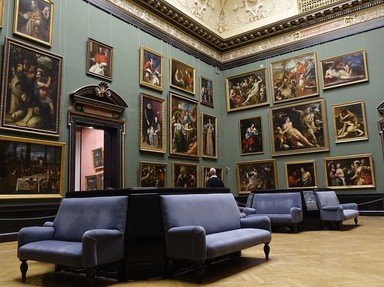Quiz Answer Key and Fun Facts
1. This 1852 painting of "Ophelia", a character from Shakespeare's "Hamlet", depicts the subject singing while floating in a Danish river just before she drowns. The Southampton-born artist was one of the founders of the Pre-Raphaelite Brotherhood. Who painted "Ophelia"?
2. "Satan Smiting Job with Sore Boils" is a work from 1826 by the English poet, painter and printmaker who in the same year published his 22 engravings now known as "Illustrations of the Book of Job". Although little known in his lifetime, he is now recognized as one of the most important artists of the Romantic Age. Who is this artist?
3. Painted in 1845 and one of his last works, "Norham Castle, Sunrise" exemplifies the style of arguably Britain's greatest Romanticist landscape painter. This is one of numerous example of his work at the Tate Britain, as the artist bequeathed his own collection to the nation. Dubbed "the painter of light", who is this artist?
4. Completed in 1745, the artist worked on "The Painter and his Pug (Self-portrait)" for more than ten years. A celebrated satirist and cartoonist as well as a artist, note how he painted the dog sitting in front of an apparent painting of himself. He is best known for a number of series of paintings that told a story. Who is this artist?
5. Painted between 1872 and 1875, "Nocturne in Blue and Gold: Old Battersea Bridge" depicts the old wooden Battersea Bridge across the River Thames. The American-born, British-based artist signed his works with a stylized butterfly with a long stinger for a tail. Active during the American Gilded Age, who is this artist?
6. Painted in 1849, "The Girlhood of Mary Virgin" is one of a small collection of works on display at Tate Britain by this English poet, illustrator and painter. A precursor of the Aesthetic movement, this artist was one of the co-founders of the Pre-Raphaelite Brotherhood. His sister was also a celebrated poet. Who is this artist?
7. The massive (144"x99") "The Death of Major Peirson, 6 January 1781" depicts a scene from the Battle of Jersey, the invasion of the Channel Islands by French Royalists. It was painted in 1783 by an Anglo-Irish, American-born artist best known for his portraits of important figures from colonial New England. Who is this artist?
8. No collection of great British art would be complete without something by the painter of the pictured "The Valley Farm". Completed in 1835, it is one of numerous examples of his work that can be seen at Tate Britain. It now seems remarkable that during his lifetime he sold more paintings in France than he did in England. Who is this artist?
9. "Portrait of the Fourth of Duke of Marlborough and His Family", a work from 1776 by one of the most influential English painters of the 18th century, is one of a dozen of his works that can be seen at Tate Britain. Best-known for his portraits of the leading figures of the era, he was knighted by King George III in 1769. Who is this artist?
10. We conclude this regrettably brief tour of great British art displayed at Tate Britain with "Mares and Foals in a River Landscape", a painting from 1763-68 by another of the country's most important artists. Do you really need another clue to the identity of this artist?
Source: Author
EnglishJedi
This quiz was reviewed by FunTrivia editor
looney_tunes before going online.
Any errors found in FunTrivia content are routinely corrected through our feedback system.

